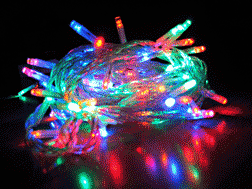A Thousand Points of LED Light
Jump on this green bandwagon
by Carrie Madren, Bay Weekly staff writer
Strings of twinkling Christmas lights line rooftops, drape doorways and trim evergreen trees. Our festive glowing lights — with their replaceable filaments and warm glow — are a tradition we hold dear.
That tradition’s about to change.
Since the early 1940s, we’ve been stringing our trees with tiny incandescent bulbs much like the one that Thomas Edison lit up in 1879. Soon technology will illuminate our homes and towns with energy-efficient LED — that’s light emitting diode — lights that burn brighter, longer and more safely.
Like the energy-miser fluorescent bulbs that have begun to shine in green homes, LED lights are a new green choice. And they’re ready to light up your holidays.
Homestead Gardens made the switch to LED lighting last year at its Davidsonville store. Now the trees that line Route 214 and the garland adorning the building host nearly half a million LED lights.
“It’s the hottest thing in Christmas lighting,” says Tim Hamilton of Homestead Gardens, which now lights up the downtown Annapolis tree each year with some 2,000 C9 bulbs.
Next year, Hamilton says, Homestead expects to light up Annapolis’ evergreen with the glowing diodes. You’ll notice the difference as you walk downtown — a brighter light from each bulb. The city budget will too.
LED lights use one-10th the energy of the traditional incandescent mini lights and last more than 50,000 hours, according to the Alliance to Save Energy. That’s because each light uses 0.08 watts, compared to 0.48 watts for a mini incandescent or six watts for the larger, old-fashioned style C7 incandescent bulb.
The new high-tech lights also have rust-proof, zinc-coated lamp contacts, which means parts won’t rust outdoors or in the elements.
“They’re smarter to use, and their life span is considerably longer,” says Rozanne Weismann of the Alliance to Save Energy. “Plus, they’re cool to the touch, so they’re not going to be causing fires.”
You don’t need to be as tender with LEDs as you stash them for next year, either.
“The LED doesn’t break; it’s virtually indestructible,” Weismann adds. Instead of glass, casings are made with an epoxy that will withstand being run over by a tractor-trailer, claims www.HolidayLEDs.com, an online retailer.
“We sold out last year and had to reorder,” Hamilton says of how Homestead customers receive the LED lights. “This year we doubled the order. Demand is high right now.”
Though the little LED light may sound like the little reindeer who saved Christmas, there is a catch: LED’s are 25 to 30 percent more expensive than the traditional incandescent bulbs.
That’s about $6 more for a 25-foot string of lights, according to Consumer Reports.
Sneade’s Ace Home Center in Owings and Solomons is selling LED bulbs for a second year. A strand of 50 LED lights costs $10.99; a strand of 60 costs $12.99. For a 50-bulb incandescent strand, by comparison, you pay $2.99; for 100 bulbs $6.99.
LED lights, however, offset the higher price with savings on your electric bill.
“A lot of people want to keep them on all the time and also keep their electricity bill down,” says Sneade’s season team leader Nicky Foster.
Using less electricity means less power needs to be generated and less air pollution spewed into our air.
Before the town of Mason, Michigan, replaced its incandescent lights with LED lights, 500 C7 and C9 incandescent bulbs, burning an average of 6.5 watts per bulb, consumed 3,276-kilowatt hours of electricity at a cost of $327 per season. This season, 1,200 C7 style multi-colored LED lights — at .08 watts per light — will use only 870-kilowatt hours of electricity at a cost of $87 — plus they will burn for more than 200,000 hours.
Burning Brighter
Like Mason, city trees from San Francisco to Washington, D.C., are making the switch this year.
Chesapeake Beach has already switched to LEDs for some of the thousands of lights that trim the town, says superintendent of public works Wilson Cochran. The newest displays, the geese and moon by Horizons on the Bay and the flood gate, already have the new bulbs.
Cochran expects that the town will replace the hundreds of strands of lights that cover all the median trees and about a dozen displays with LED strands next year.
“Normally, we replace about 1,000 lights each year,” he says of the incandescent bulbs. “I know I bought over 1,200 [replacement] lights this year — just for the bulbs that were broken or burnt out.”
In Washington, DC, the National Tree — on the ellipse in front of the White House — shines with LED lights for the first time this year, says National Park Service spokesman Bill Line. General Electric trimmed the 43-and-a-half-foot-tall Colorado blue spruce in 780 strands of LED lights. Each strand has 26 lights for a total of 20,280.
Rockefeller Center has switched to LEDs this year. That’s a big deal because the New York City tree is among the most famous in the country.
“In five years,” predicts Hamilton, “LED will be all that’s available.”